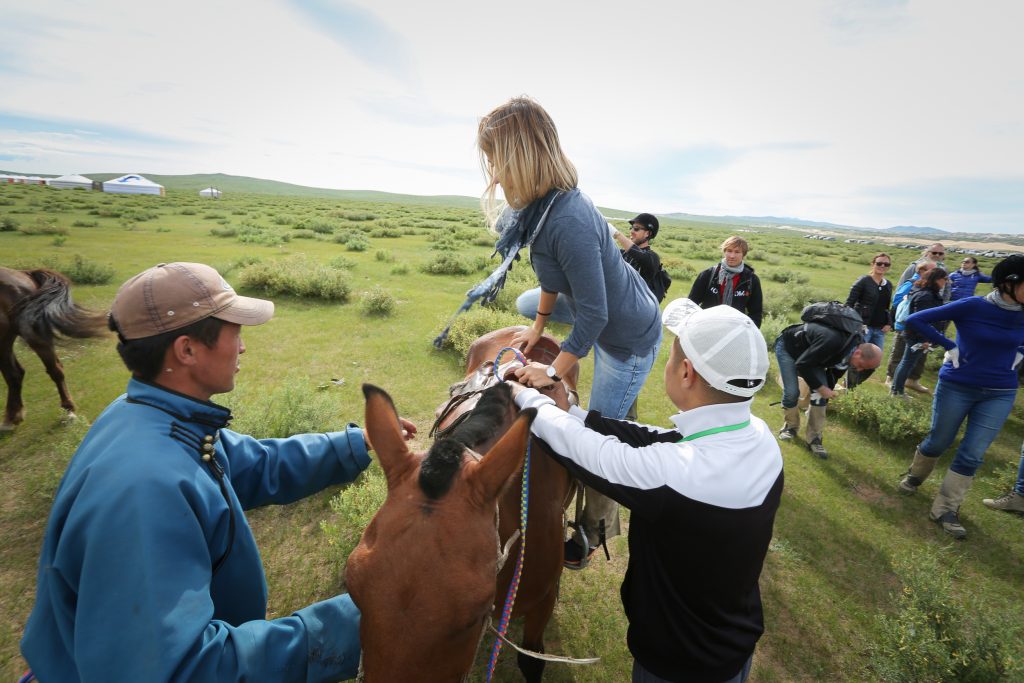Riding a Mongolian horse is not an easy thing to do. One might call it a responsibility, even.
Even though nomads train their horses, unlike the western culture, Mongolian horses are more autonomous, self-sufficient and can survive on their own. Which means they can be a bit rough and at its own will.
Your respect for your horse will be the foundation of a great & safe ride, so treat him like a friend. Your horse is like your reflection in a mirror; just like people, they think, feel and makes decisions.
Here are some rules and advice to respect for your comfort and safety when riding.

Must Know:
- Always mount from the left side of your horse;
- Never walk close behind a horse, as it might startle and kick you;
- Avoid any big gestures or pulling in order to not stress the horse.
- Avoid speaking too loud and do not shout;
While you are mounted, if you want to remove your jacket or put things in your backpack, always inform your guide first, stop your horse, get off and do them;
Drift from your path a little if you see metal objects, plastic bags, large branches of wood or bottles on the ground, since they might hurt or startle your horse when stepped on;
Avoid passing near families of nomads. The dogs run and bark after you, and the horse might kick and collapse you;
Preferably, do not let your horse eat too much grass or drink in the rivers. On hot days and after galloping, your horse will pant too much and tire out.
Mounting Your Horse
On our tours, your horse will be equipped with a beautiful and comfortable western leather saddle and you will be aided by a local guide with their own horse. You’ll ride like a real cowboy or nomad in the steppe!
A Mongolian horse is trained to always be mounted from its left side. Before mounting, ask your horse guide to check all the straps, the attachment of the saddle and the length of the stirrup. When you’re ready, the guide will help you get on correctly.
Hold your saddle securely to give you support and strength when mounting up and throw your right leg over the horse, so you don’t hit the horse. Once you are seated on your saddle, make sure that the height of the stirrup is well suited to the length of your legs. If they are too short, you might get tired quickly and hurt your knees, but if they are too long, your feet will not have anything to hold on to.


While on the horse, pay attention to the position of your feet as well. You should enter only 1/3 of your feet into the stirrups. This is important for when you need to get off quickly in case of sudden departure of your horse when you’re mounting or riding.
You should be comfortable and show confidence while on the horse. It is very important to be in control of your companion, because if they feel your serenity and your domination in your gestures, the horse itself will be confident in you.
Take the reins on either side of the neckline in your two hands, these serve for steering. Always keep the reins in your hands. Do not hold them too tightly or wrap them around your fingers, and leave a little flexibility so as not to pull on the horse’s jaw too much and injure it.


Riding Your Horse
For beginners, a guide will always hold your horse during the ride and can gently introduce you to trotting if you wish.
For more comfortable riders, the guide will give you the rope that they use to lead your horse. This rope must also be in your left hand at all times and the goal is to use it as a whip by pronouncing the word “Tchou, Tchou“. Depending on whether you want to trot or gallop, you must intensify your stroke and the word “Tchou”.


While riding, don’t undergo the movement of your horse, but be in rhythm with it. Have a straight position, remembering the 1/3 of your feet in the stirrups and position your heels down to give you the right position and support .
To go to the right, pull on the reins to your right and vice versa to go to the left. To stop your horse, pull the reins backwards, but not too hard and watch out for the jaw.
Horses have a natural herd instinct and prefer to stay in a group, that’s why if you ride away from your guide or colleagues, they will try to catch up with the others.
If you are tired, do not hesitate to tell your guide. You can always walk and hang out next to your horse. Remember to wait until your horse has completely stopped to get off.


Descending From Your Horse
For beginners, your guide will stop your horse and help you to descend smoothly. Pay attention to the position of your foot, make sure it is not hooked in the trellis, as well as your clothes.
Do not remove the saddle off your horse too quickly, because the body temperature must be regulated calmly to avoid marks and bleeding on its back.
Do not forget to thank and greet your horse… it is a divine animal!



The whole team wishes you a pleasant journey on your trusted steed in the land between heaven and earth!
Disclaimer: Photo credits to rightful owners







